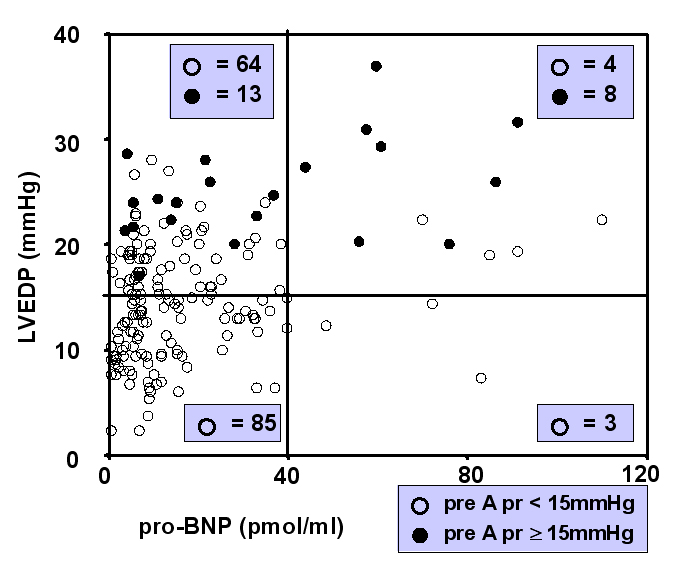| №ЯЗҐЗьЅД : ±ёї¬
|
Бўјц№шИЈ - 470044 36 |
| Pro-BNP as a noninvasive predictor of elevated left ventricular filling pressures in patients with normal systolic function |
| Cardiology Division, Yonsei Cardiovascular Hospital and Research Institute, Yonsei Universitiy College of Medicine, Seoul, Korea |
| Boyoung Joung, Jong-Won Ha, Young Guk Ko, Seok-Min Kang, Se-Joong Rim, Yangsoo Jang, Namsik Chung, Won-Heu Shim, Seung-Yun Cho |
Background: Brain natriuretic peptide (BNP) is released from the cardiac ventricles in response to stretching of the chamber. It has been shown as a good predictor of high left ventricular end-diastolic pressure (LVEDP) in patients with systolic dysfunction. However, whether BNP can predict high LVEDP in patient with normal systolic function is not known. The purpose of this study was to investigate whether pro-BNP can help identify patients with elevated LVEDP or filling pressures (pre A pressure), or both. Methods: LV pressure was measured by fluid-filled catheters in 177 consecutive patients undergoing diagnostic cardiac catheterization. Pro-BNP was measured at the time of catheterization using a quantitative electrochemiluminescence immunoassay. Results: Log pro-BNP levels correlated significantly with LVEDP (r = 0.34, P < 0.001) and pre-A pressure (r = 0.33, P < 0.001). Pro-BNP above 40 pmol/l predicted LVEDP ≥ 15 mmHg (sensitivity of 13%, specificity of 97%) and pre-A pressure ≥ 15 mmHg (sensitivity of 35%, specificity of 95%). Among patients with high LVEDP (≥ 15 mmHg), elevated Pre A pressure (≥ 15 mmHg) was more common in patients with higher pro-BNP (8 of 12, 67%) than lower pro-BNP (13 of 77, 17%, p < 0.001). Conclusion: Pro-BNP was correlated significantly with LV diastolic pressure and pre-A pressure, and its concentration above 40 pmol/l can predict an elevated LVEDP with high specificity in patients with normal systolic function.
|
|
|
Warning: getimagesize(/home/virtual/circulationadmin/htdocs/econgress/conference/abstract/img_files/Untitled-3copy.jpg) [function.getimagesize]: failed to open stream: No such file or directory in /home/virtual/circulationadmin/new/econgress/conference/manage/schedule/view_abstract.php on line 164

|
|

